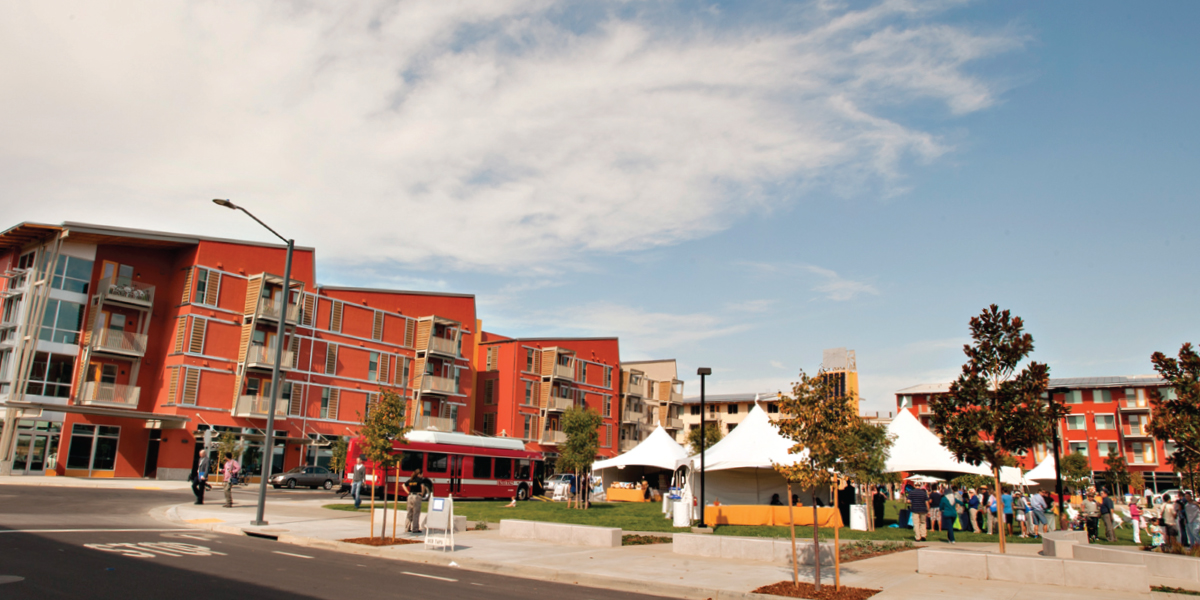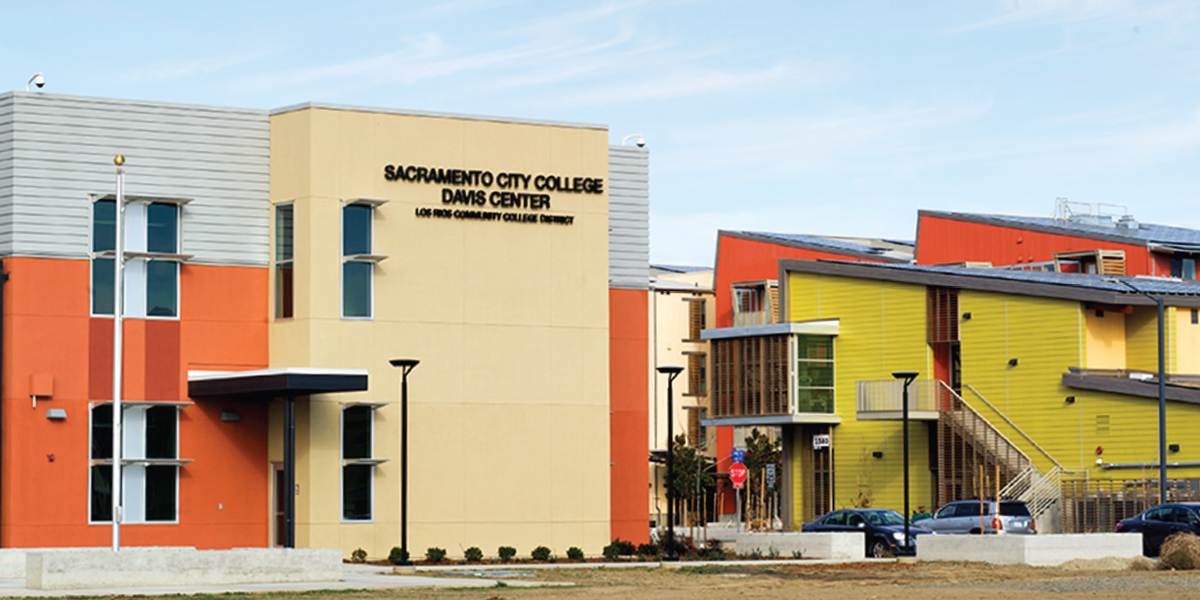Historically, the University of California, Davis (UC Davis) and the local community grew at roughly the same rate. Davis, a true college town, typically housed 90 percent of our 26,000 students, 60 percent of faculty, and 40 percent of staff.
Those percentages, however, had begun to diminish by 2000, when the university began a long-range development plan. Housing prices in Davis, which were already relatively high, kept increasing while the supply remained limited. The situation forced many of our students and employees to live in surrounding communities and take on longer commutes.
Based on various factors, including state demographics, the university’s long-range planning process projected significant growth, with student enrollment estimated to reach 32,000 by 2015. But with housing already in short supply, where would the additional students—not to mention the faculty and staff to support them—reside? How could the opportunity to live in this college town community continue to be an asset for recruitment and retention of faculty, staff, and students?
One answer would be UC Davis West Village, a new mixed-use development that would be placed along the northern edge of the 3,700-acre campus. The university already owned the farmland, which was being used by several agricultural departments but not for long-term research.
In the larger community, however, growth had such a negative connotation that it was known as “the G word.” Perhaps because the city of Davis had experienced rapid growth in the 1980s and 1990s—more rapid than many residents liked—the city council passed a new ordinance not long before the university made its decision to build a new campus community. The ordinance automatically required the voters of Davis to approve any new development proposed for open land.
The university was not bound by this ordinance; only the University of California Regents must approve its growth. Before going ahead with the project, however, we wanted to gather ideas from members of the community and openly share the challenges of creating more access for local housing. And so began two and a half years of public meetings.

A Public Dialogue
Some of the meetings were small, involving members of a city commission or neighborhood group. Others took the form of town-hall forums that attracted 200 or 300 attendees. Many people struggled with the trade-offs that local university-centered development would bring.
We used the meetings to have public conversations about the impacts of various scenarios. If, for example, the university left housing to be built farther away, in cities other than Davis, how might that affect local and regional traffic congestion, commuting times, and air quality? If we located the new development nearby, on existing university land, how might the community share amenities?
Talking through the project in public and hearing people’s ideas definitely influenced our planning. In response to ongoing concerns about growth, UC Davis downsized West Village twice, to occupy 130 acres rather than nearly 400. A village square designed to provide a social and physical connection to adjacent neighborhoods was moved, at homeowners’ and city officials’ request, to a more internal location. The university also eliminated direct street access from the surrounding neighborhoods, leaving only bicycle and emergency vehicle connections.
In 2003, the UC Regents approved the university’s long-range plan and the environmental impact report—required by California law—for the West Village development. Shortly thereafter, as we anticipated, a neighborhood group filed a lawsuit that alleged inadequacies in the environmental analysis. Another year went by before both the lower and appeals courts decided in favor of the university.
From the start, given statewide budget constraints, we knew we would need to partner with the private sector to construct West Village. After extensive research, we selected a company that had developed several mixed-use communities (although none on a college campus) and had the financial stability to make the long-term commitment to West Village. While UC Davis spent approximately $17 million to bring utilities to the site’s border and retains ownership of the land, the developer agreed to invest approximately $280 million in community infrastructure, residential and mixed-use buildings, and open spaces.
Typically, the village square would be the last piece put in place in a mixed-use development. We preferred that the village square be built first, to provide a social hub for residents. As an incentive for the developer, UC Davis agreed to lease back 75 percent of the 42,000 square feet of ground-floor office and retail space in the buildings surrounding the village square; the remaining three floors in each building contain rental apartments.
Expanded Programming
In 2006, as design work got under way, other partnerships evolved. From the outset, we had envisioned West Village as being bike- and pedestrian-friendly, with the campus bus line no more than a quarter-mile from each residence. Then Campus Planning contracted with the UC Davis Energy Efficiency Center, an academic unit on campus, to conduct several studies. We concluded that West Village would benefit from aggressive investments in energy efficiency and even held the potential to be a zero-net energy (ZNE) community—one that generates as much energy over the course of a year as it consumes.
Although not part of our original agreement, the zero-net energy concept resonated with the developer, who saw not only a marketing distinction but also the opportunity to develop and test new building practices.
Working in partnership with both private companies and public agencies, we investigated solar panels, biodigesters, fuel cells, high-efficiency mechanical systems, and conservation incentives. Their input, in addition to $7.5 million in federal and state grants, enabled us to design West Village as the largest planned ZNE community in the country, well ahead of the deadline set by the California Public Utilities Commission to shift all new residential construction in the state to ZNE by 2020 and all new commercial construction by 2030.
Beyond its sustainability features, we wanted the new community to have a “heart.” Because West Village would primarily house people connected with UC Davis, it made perfect sense to place education at its core. That decision led to another partnership, this time with the Los Rios Community College District, which serves more than 90,000 students.
UC Davis approached the district, which had recently passed a local bond to fund new construction, about the possibility of building its next location in West Village. The enthusiastic response eventually resulted in construction of the $7.4 million, 20,000-square-foot Sacramento City College Davis Center.
This cross-sector partnership within higher education—the first community college center built on a University of California campus—holds great promise for collaborations and encouraging transfers. Our hope is that more community college students will feel comfortable and motivated to make the transition to a four-year university, either at UC Davis or elsewhere. In addition, UC Davis students can take classes at the center that aren’t currently offered on the main campus.
To make the heart of West Village beat even stronger, we filled much of its office space with the university’s energy-related centers and institutes, including the Plug-In Hybrid & Electric Vehicle Research Center and the Western Cooling Efficiency Center. Grouping the six centers, which had previously been scattered all over campus, created what our chancellor calls a “uHub”—an environment that encourages sharing, collaboration, and innovation among academic units as well as the public and private sectors. West Village itself serves as a living laboratory for the research undertaken by the various centers.

Construction Continues
The Sacramento City College Davis Center opened in 2012 and currently enrolls about 2,300 students (about 10 percent of whom eventually transfer to UC Davis). The village square is also home to a restaurant, cafe, convenience store, and student recreation center. With the third apartment complex nearing completion, West Village will soon provide housing for nearly 2,000 students. The rental units, which have a 99 percent occupancy rate, feature rooftop solar panels, thick exterior walls for added insulation, sunshades to reduce solar exposure, high-efficiency air conditioning systems and appliances, and ceiling fans.
American Honda Motor Co. chose West Village for the site of its Honda Smart Home USA, which broke ground in April 2013. In cooperation with UC Davis energy research centers, Honda plans to use the building as a ZNE demonstration home, complete with an electric car.
Plans are also under way for up to 343 single-family houses, each ranging from 1,400 to 2,000 square feet. The traditional Davis-style neighborhood will feature front porches, alleys, gardens, and small community parks. About 60 percent of the homes will have a small rentable flat above the garage, further increasing residential density and opportunities for student rental housing.
Homeowners in West Village must have a university affiliation. And, to encourage bicycling, walking, and bus riding, homeowners will not be eligible for a parking permit on the main campus. The goal is for the single-family homes to be priced below the private market, with annual appreciation capped to keep them affordable for future generations of faculty and staff.
The extraordinary rise in housing prices in the 1990s and early 2000s provided much of the impetus for the West Village project. Halfway through the planning process, however, the housing slump occurred: Housing prices in Davis declined about 21 percent between 2007 and 2011, thus undercutting the financial feasibility of below-market housing. This market reversal underscored the importance of building a mixed-use community; while the single-family home market took a hit, apartment rentals were strong because student enrollment at UC Davis grew much as projected.
Rather than being built first, as originally planned, the single-family residences will likely be built in small phases as homes are pre-purchased. That was just one of several unpredictable events that arose as our decade-long planning process unfolded. At the start, more than a decade ago, we also would not have anticipated having the opportunity to experiment with the zero-net energy concept on such a large scale—which, based on initial data, seems to be working.
Although the path to West Village took some unexpected twists along the way, UC Davis arrived at the destination it always intended: responding to growth by working with the private sector to provide a new, vibrant campus community.
ROBERT B. SEGAR is assistant vice chancellor, campus planning and community resources, at UC Davis.


